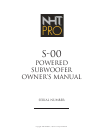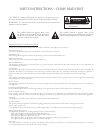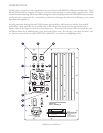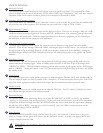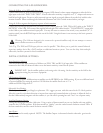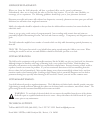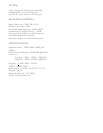
SUBWOOFER PLACEMENT:
SYSTEM MAINTENANCE:
Where you locate the S-00 subwoofer will have a profound effect on the system's performance.
Unfortunately, there are no hard and fast rules to find the best location. If you have some flexibility, we
encourage you to experiment. The following guidelines should help you in your placement decisions:
Placement near walls and corners will reinforce low frequencies; conversely, placement out into open space will add
definition, but will reduce bass weight and extension.
Ideally, the subwoofer should be adjusted so that you hear the additional bass extension, but cannot localize the
subwoofer itself.
Listen as you go, using a wide variety of program material. Jazz recordings with acoustic bass and piano are
particularly helpful in determining location, sub level and crossover settings. Transparency and integration are the
goals.
The S-00 subwoofer amplifier has a number of controls which can help while determining optimal placement; try
them all!
TECH TIP: The bypass foot switch is very helpful when setting up and tuning the S-00 to your room. When
switching the woofer in and out, no tonal difference should be noticeable, just bass or no bass.
Your S-00 subwoofer needs no regular maintenance. The S-00 cabinet is finished with a durable, powder-coat paint.
Light dusting is usually sufficient, although the cabinet can be cleaned with a non-abrasive, water based, cleaner. The
grill covering the woofer is mounted internally and is not user serviceable.
WARNING: To avoid risk of electrical shock, do not remove the amplifier from the rear of the cabinet.
Refer all repairs to a qualified authorized service center. Always disconnect the S-00 from the AC power
source prior to any maintenance.
:
Toll free: 800-NHT-9993 (648-9993). Fax: 1-707-747-1252. Email: tech@nhtpro.com.
Postal Mail: NHTPro, 6400 Goodyear Rd., Benicia, CA 94510
SYSTEM OPERATION:
The S-00 used in conjunction with good satellite monitors, like the M-00's, can play very loud with low distortion.
Although designed to handle a wide range of listening levels, every speaker has its limits. Harsh breakup is an
indication your monitors or the subwoofer have exceeded their output limits. Excessive boosting of bass, treble or
equalizer controls can worsen the problem. If you hear continuous distortion or feel heat emanating from the
drivers, reduce the level immediately. Most speaker damage occurs from sustained high volume levels, not from
transient sounds or brief musical peaks. Listening at high volume levels is potentially dangerous and can lead to
permanent hearing loss, especially when listening in the near-field. Protect your ears and use common sense.
TECHNICAL SUPPORT:



